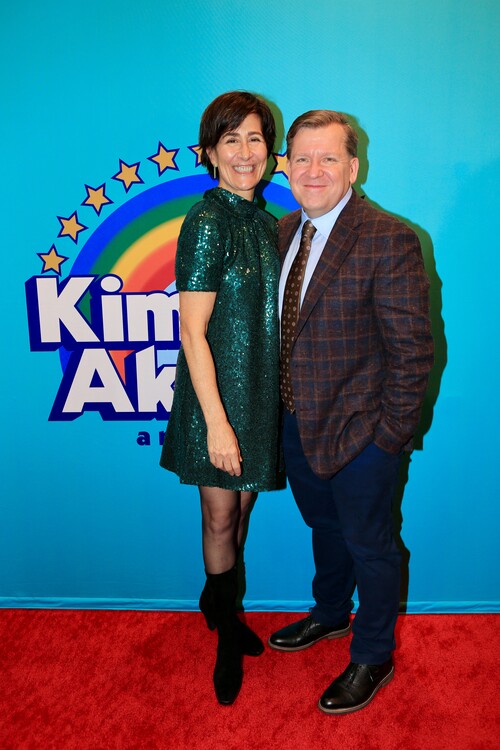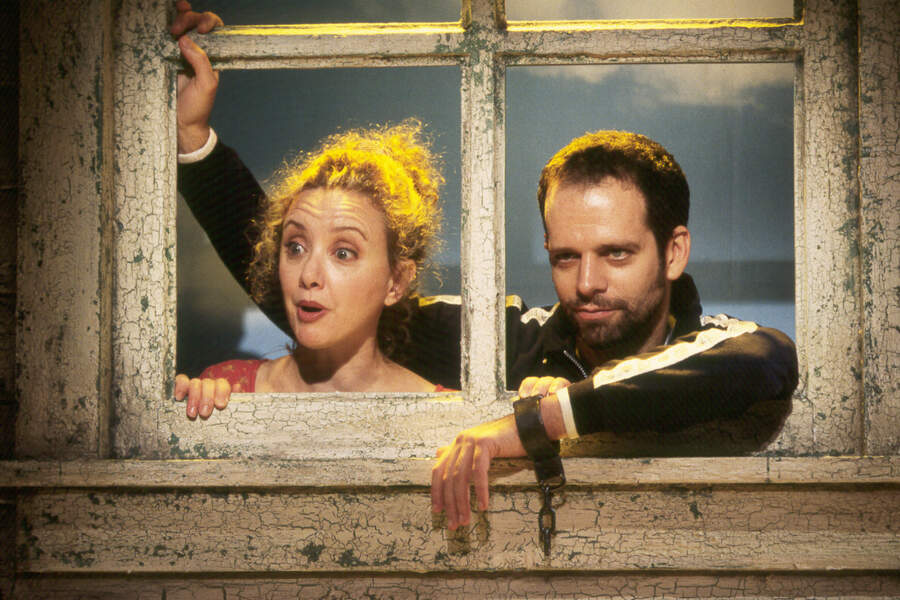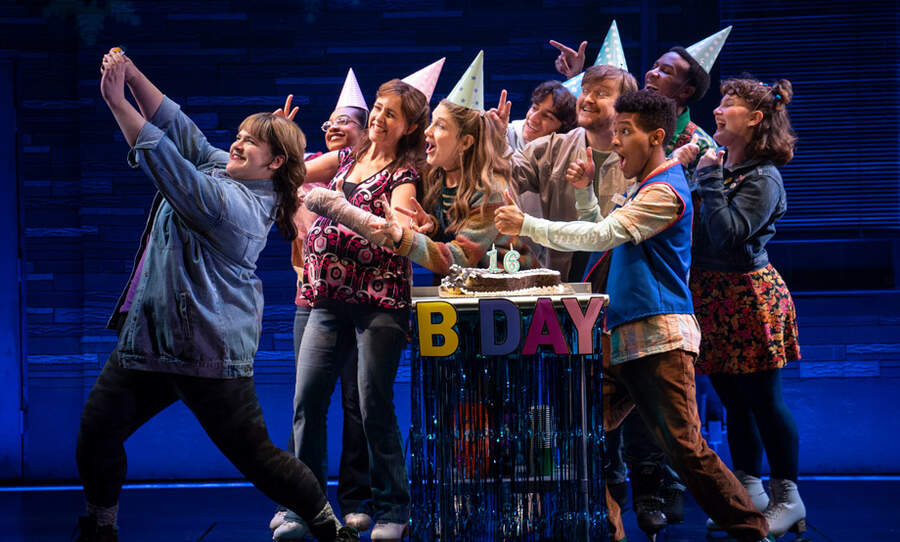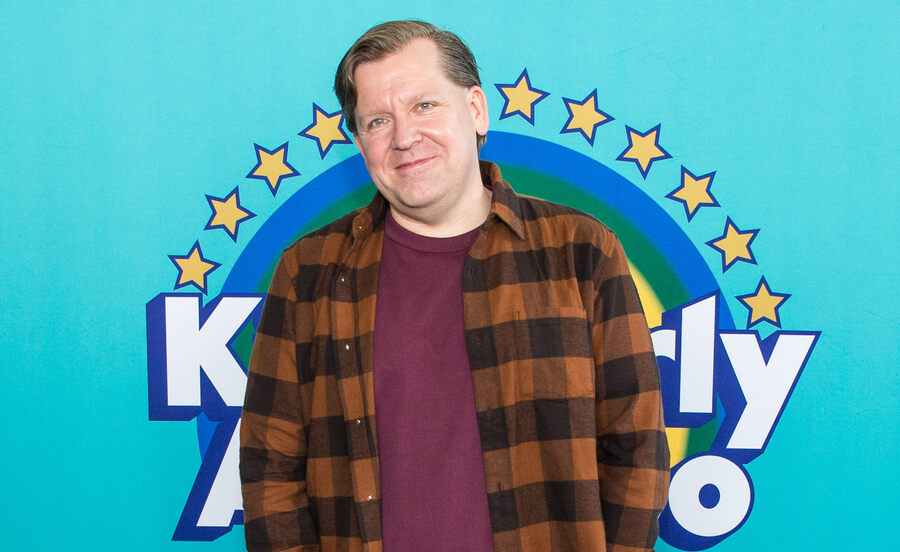For years, Kimberly Akimbo sat on a shelf. It was a cherished part of David Lindsay-Abaire’s past, an Off-Broadway play filled with what he now thinks of as the “whimsy” and “willful mayhem” of his youth, but it was a style that had largely given way to naturalism in works like the Pulitzer-winning Rabbit Hole and the Tony-nominated Good People.
Along the way, Lindsay-Abaire had also served as a hired gun on musicals, writing the book for High Fidelity and the book and lyrics for Shrek. He found both experiences less satisfying than writing plays. On the former, he was envious that someone else (Amanda Green) got to write the lyrics, which, as he put it in a recent interview, contain “the meat of the narrative. I’m a word puzzler, so I love lyrics and figuring out the puzzle of a song.” In the case of the latter, that it was a corporate media property meant “there were lot of people with a lot of opinions, and I was constantly defending first drafts.”
One good thing that came out of the Shrek adaptation, though, was his teaming with composer Jeanine Tesori. It had never occurred to Lindsay-Abaire to revisit Kimberly Akimbo. As he put it, “I wouldn’t rewrite an old play—it is a reflection of who I was and the world around me at a specific time—and I would never have thought of making it into a musical.”
That is, until one day, as he was musing to Tesori that he’d love to write a musical the way he writes a play, a process he described as, “It’s just me, by myself, and it’s bad for as long as it needs to be, and nobody’s breathing down my neck and giving me notes before I’m ready,” he explained. That sounded fantastic to Tesori, he recalled, who suggested he try adapting one of his plays. “I said, ‘I don’t understand—my plays are my plays.’ But she pulled Kimberly off the shelf and said, ‘This play sings, and here’s why.’”

Tesori was on to something. Kimberly Akimbo, which tells the story of a teenage girl with a disease that prematurely ages her, against the backdrop of downscale working-class New Jersey exurb, is currently on Broadway, where it’s a leading candidate for a Tony nomination. (It already won numerous awards for its Off-Broadway run at the Atlantic Theater Company.)
The musical’s director, Jessica Stone, sees the resulting musical as representative of Lindsay-Abaire himself. “David has a wicked sense of humor, and we laugh together until I cry,” she says. “My second favorite thing about him is his intellect. He cuts through artifice like a laser; he doesn’t have an inauthentic bone in his body.”
The musical shares much not only with the original play but also with most of Lindsay-Abaire’s writing: It is frequently funny, with humor that is alternately silly and sharp; it focuses on working-class characters; and it features a female protagonist. (In Rabbit Hole, the couple whose young child is killed by a car is affluent, but the mother comes from a working-class family.)
Those traits can largely be traced to Lindsay-Abaire’s own childhood, though at the time he couldn’t have imagined the career he carved out.
“I loved books and plays and I was always writing shitty stories and bad poems,” said the Boston native, 53, who now lives in Brooklyn. “But I was a working-class kid from Southie—I didn’t know any writers. Are they even real people? I barely considered going to college until later.”
These days, Lindsay-Abaire is a prize-winning writer living in a vast Victorian home in Brooklyn’s Prospect Park South, but he said a working-class sensibility still permeates everything he does.
“I’ve had great privileges in my success and I appreciate them,” he said. “But the working-class kid in me says, ‘That can all go away tomorrow, so appreciate it—but keep working.’ That insecurity, feeling there’s something fragile about where you are in life, comes from being working-class.”
He’s not complaining about his background. He attributes his work ethic to his parents (“I get up every day and I work from 10-6 and I have 45 minutes for lunch; I’m a worker”) and his sense of humor to the trials and tribulations they faced. “Every inch of my life was shaped by the fact that we didn’t have a lot of money and that horrible things happened in my family and in the neighborhood,” he said. “When you’re surrounded by awfulness, often the only way to get through it was by laughing at it. From an early age, comedy and tragedy lived right next to each other.”
Lindsay-Abaire’s path first shifted in seventh grade, when a Boys & Girls Club scholarship sent him to Milton Academy, a private school in the suburbs. He started seeing plays, taking theatre classes and acting. Every 9th grade class put on a play, and his year it was A History of the American Film by Christopher Durang. “It was an insane, wonderful musical and I thought, ‘Wow, plays can be that?’”
The next year, another student decided the class should put on another play and turned to his wise-cracking friend.
“He said, ‘You’re the funny one, so you should write it,’” Lindsay-Abaire recalled. The job stuck; he went on to write shows for each subsequent year in high school. But when he got to Sarah Lawrence College, he thought being an actor was more realistic. Then he applied to and got into Juilliard’s writing program, and his world changed.
“In the first weeks, Chris Durang and Marsha Norman would say things like ‘As a playwright, you will notice…’ or ‘When you are working with a director…,’” he said. “They were talking to us as if we were going to be playwrights.”
Juilliard was transformative in three ways, according to Lindsay-Abaire. First and foremost were Durang and Norman, who were endlessly supportive without being didactic. “They were adamant that we explore our voices and the stories that we specifically needed to tell,” he said. “And there weren’t strict rules about what a play could or should be; having the time and space and the permission to explore that was invaluable.”
Second was the constant exposure to theatre, to the work of writers like Durang, Tina Howe, and John Guare, who showed that plays could be funny “but also deeply disturbing and peppered with hurt and pain underneath.”
Finally, and equally significant, he said, was his classmates’ decision when the program ended that they should stay in touch and keep giving each other feedback. Decades later, that writers’ group is still a staple in Lindsay-Abaire’s life. “It has grown and shrunk and has some new people,” he said, “but every play I have written has gone through there.”

Lindsay-Abaire wrote his breakout play, Fuddy Meers, about an amnesiac trying to make sense of her life, at Juilliard. It debuted at the Eugene O’Neill Theater Center’s National Playwrights Conference, then off-Broadway at Manhattan Theatre Company. It went on to become one of the most-produced plays in the U.S. for two years in the early 2000s.
Like the plays that followed, Fuddy Meers centered on a female lead. Lindsay-Abaire has three explanations for this recurring tendency in his work. For one thing, he said, “My mother was an amazing storyteller and hilarious and the center of every family event and a soulful person and problematic and complicated.” As a young playwright, he also saw that most plays featured men as leads, while amazing actresses often starved for meaty parts. “So if I was starting a play, my default was to make the lead a woman,” he said.
Over time, he has come to realize may have a third, possibly less innocent reason.
“We’re always writing about ourselves—we can deny it as much as we want, and I deny it all the time—but you cannot stop,” Lindsay-Abaire said. “By making the lead a female, it gave me the distance to say, ‘I’m not writing about myself, I’m writing about this other person.’”
Beyond those constants, Lindsay-Abaire’s work has gone through some stylistic evolution. His early plays aped the style of absurdists like Durang and Eugene Ionesco, but he grew tired of critics who seemed to think that quirky was all he could do.
“The spiteful, cynical part of he said, ‘I can write a naturalistic play if I want to,’” Lindsay-Abaire says. It’s a good quote, but let’s be honest: Lindsay-Abaire is so consistently warm and affable—and people who work with him or know him socially describe him that way too—that it’s hard to imagine him being driven either by spite or cynicism.
Whatever the motivation, he thought back to Marsha Norman’s advice, to write “what terrifies you the most.” So Lindsay-Abaire, then a parent of young children, reflected on what the loss of one of them would do to him. The resulting drama, Rabbit Hole, garnered acclaim, though he recalls critical reception of the play as a wash—some wrote, essentially, that he’d finally grown up, while others accused him selling out. Still, nabbing the Pulitzer certainly didn’t hurt his career. “It gives you something you probably don’t deserve,” he said, “and you start getting more calls.”
One of those calls was to write the screenplay for the film adaptation, with assurances from star Nicole Kidman and her team that it would be not be handed off to another writer to make it more Hollywood. He counts the 2010 film Rabbit Hole, which also starts Aaron Eckhart and Dianne Wiest, as his most satisfying experience writing for film. Still, he said, “If there’s something I care about deeply, I’m going to turn it into a play.”
Writing in a realistic vein taught him that he’d been ignoring “a whole toolbox because I was young and willful.” That led directly to Good People, about a single mom struggling to keep her life together, which, though it has comedic elements, Lindsay-Abaire felt had to be told naturalistically. “That was the most explicit version of the people I grew up with, and I didn’t want them to be dismissed as characters because they were in an absurdist world,” he explained.

He said he sometimes mourns the freeing “lack of wisdom” of his youth, which has been replaced by a deeper understanding of his craft. And Lindsay-Abaire found he still had enough whimsy to transform Kimberly Akimbo into a musical. But he did enter this project with a different perspective.
“When I wrote the play, my focus was on those teenagers,” he said of the play’s high school milieu. “The character of Seth is essentially who I was at 16. I was not aware of it, but I was clearly working through my relationship with my parents.”
Now, of course, he’s the grown-up, a dad with two kids of his own. “Now I can say of the parents, they’re not such monsters—they’re narcissists and acting out, but they’re terrified of losing their child.”
Beyond a more mature outlook, he gives much of the credit for the show’s style to Tesori. “I’m a structuralist, but she’s so free-form it frees me up,” he said. When he complained that the mother’s “slightly unhinged monologue to a video camera” seemed impossible to turn into a traditional song, Tesori told him, “You don’t have to do anything. I’m going to set some of the monologue to music.” That, Lindsay-Abaire said, “got me to ease up, to see it doesn’t have to be strict rhymes and meter all the time. That was so illuminating.”
Other songs sprang from what Lindsay-Abaire called his “pages of noodles,” which he would append to the lyrics of a song when he handed them over to the composer. These might be a single quatrain, a funny line, or a random bit that just didn’t quite fit in. Tesori, he said, would often figure out a way to make these odds and ends it work in a song, structure be damned.
It helps their collaboration, Lindsay-Abaire said, that neither he nor Tesori are precious about material. After seeing the run at the Atlantic, they wrote a new Act One closer “that gave Kim more agency, and was also more of a bop.” Other changes between Off-Broadway and Broadway were more “scalpel work” to sharpen the writing. “It was just a couple lines cut here, a few rewritten over there, but cumulatively it made a huge difference in terms of clarifying the arc of the show.”
Lindsay-Abaire’s open-mindedness and ability to move from absurdism to naturalism, and from plays to musicals, has been a plus in his other job, at Juilliard, where he and fellow alum Tanya Barfield have taken up where Durang and Norman left off.
“David is an incredibly kind and humble man, both personally and as a professor,” said Barfield, who praises his vast knowledge of plays and films and his ability to clearly see the nuts and bolts of a play. “I personally think he’s a genius, but he approaches school with respect for the student’s process and creativity without trying to impose anything.”
Both Barfield and Lindsay-Abaire take a less-is-more, “first do no harm” approach to play critiques, though Barfield noted that “students this year seem to be craving a little more of our knowledge.”
Lindsay-Abaire admitted that he often struggles with figuring out how much and what to say. “I generally feel like I know what they need, but I seldom feel like I know what they need to hear,” he said. “Every playwright needs something different, and sometimes they themselves may not know. I could give a prescriptive note that could unlock the play but that may not resonate or be helpful. I also don’t want them to write the play that I want to write. We’re constantly recalibrating and trying to let them lead the discussion and be as careful as we can.”
For Lindsay-Abaire, who is currently writing a movie, finishing a play, and discussing two musicals with Tesori, teaching doesn’t distract from but rather helps his writing.
“If I’m constantly asking students hard narrative questions, it drives home the same questions for me and keeps my muscles toned,” he said. “More importantly, my students are bringing such thrilling, different stuff that I feel inspired by them. I often leave thinking I want to go home and write.”

There is one time of year, however, when Lindsay-Abaire does slack off from the writing. Each fall his Brooklyn home becomes a mini-tourist attraction thanks to his increasingly elaborate Halloween decorations. It started when his family moved in and a neighbor asked Lindsay-Abaire and his wife to take over hosting a small Halloween parade on the block for local kids.
“I decided to get some lights and some webbing and one animatronic creature,” he recalled. “The next year, I said, ‘This is a big porch; I’ve got to get a couple of zombies and a Dracula.’ The next year, I said, ‘I could put some skeletons up on the turret.’” Now, 10 years later, he said, “There are 60 animatronic monsters in our basement waiting for October. I am a completist, and may have some undiagnosed OCD.”
The spooky décor attracts crowds for weeks, including thousands on Halloween itself. Lindsay-Abaire said that one thing he loves about it is that most of the people (and all of the kids) have no idea he’s a playwright. “My favorite thing is, it’s mostly separate from my career,” he said.
It has occasionally competed with his own playwriting fame. One year at Sundance, he recalled, he met a young playwright who seemed unimpressed by his Pulitzer-winning, Tony-nominated works. But when he mentioned he lived in Brooklyn and told her the cross streets, the woman suddenly paid attention.
“Her eyes lit up and she said, ‘Are you the Halloween House?’”
Laughing at the memory, he added, “I thought to myself, ‘I wish you liked my plays as much as my Halloween decorations.’”
Stuart Miller (he/him), a writer based in New York City, is a frequent contributor to this magazine.


